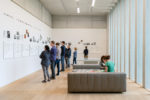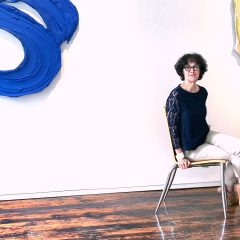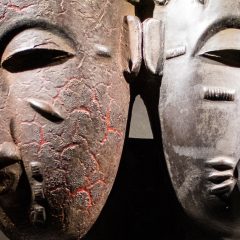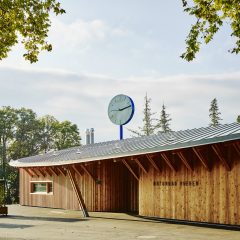—>Sit back and enjoy Rachel’s trip to Zurich, with a surprising number of conceptual art shows in galleries and museums and lovely vistas of the old city. –the Artblog editors——————>
Banks, cleanliness, the Alps – people’s world view of Zurich does not immediately zero in on contemporary art. But, as one of the richest cities in the world, Zurich is filled with commercial galleries that decorate the homes of the city’s wealthiest. I was not expecting great conceptual art, but was quickly – and happily – proved wrong. One week hopping Zurich’s efficient trams with locals revealed some incredible contemporary spaces and historical gems.
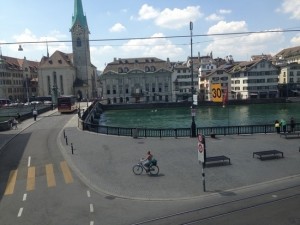
The best place to start your search for contemporary art in Zurich is the website, Art in Switzerland. The site provides a guide to contemporary art exhibitions in Switzerland, with special emphasis on Zurich galleries. It also publishes an annual, free pocket-size guide to the city’s contemporary art scene that includes maps and gallery descriptions. Check out the website before your visit and scope out the pocket guides in gallery windowsills. You cannot miss the bright red cover.
Conceptual art in the gallery district
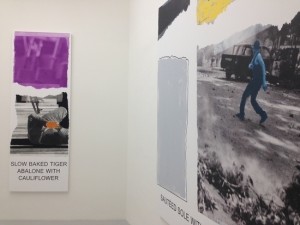
A stream of contemporary art galleries is nestled between the Bellevue-Platz and the Kunsthaus, Zurich’s modern art museum. At the Mai 36 Gallerie on the Ramistrasse, a show of new works by celebrated artist John Baldessari just closed on July 27. The exhibition, “Morsels and Snippets,” presents 13 large-format works that combine text and image on canvas. The images are reconfigured newspaper clippings with themes such as political uprising and gun violence, while the text presents names of gourmet dishes like “Palm Heart, Sea Scallops, Pear Seaweeds, and Citronella.” This absurd combination of sight, taste, and imagination presents a seemingly light-hearted critique of contemporary culture and media, as Baldessari boldly points out our cultural obsession with gourmet food and culinary trends in the face of continued poverty, struggle for representation, and institutional control. The series, as can be expected from Baldessari, is brilliant.
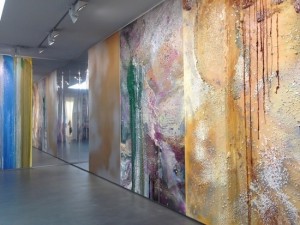
Near Mai 36 Gallerie along the Waldmannstrasse is Galerie Andrea Caratsch with an exhibition by contemporary Swiss artist John Armleder on view through September 27. The exhibition begins with three mirrored planes, each presenting miniature collaged mirrors cut into geometric shapes and glued down into a horizontal whole. The pieces create their own reflective symmetry, grabbing hold of the gallery’s shapes, colors, and light. After being transfixed by this minimalist simplicity, the viewer enters a large square room covered floor to ceiling in glitter-splattered foil. One part five-year-old’s birthday party and one part expressionist abstraction, Overload is overwhelming and magical at the same time. As a whole, the exhibit’s flamboyant and simplistic dualities of mirrored self-perceptions create a thought-provoking metaphor for the alternating chaos and tranquility of contemporary life. [Armleder showed at ICA in 2006, where, one evening, he and Christian Marclay performed a Fluxus-inspired sound performance that was merry and child-like. Read the artblog post.–Ed.]
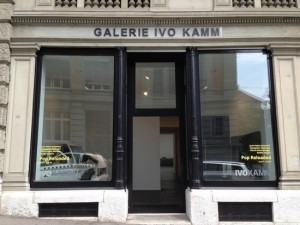
Next door to Overload, you’ll find “Pop Reloaded” at the Ivo Kamm Gallerie. The exhibit features a contemporary Helvetian/Latin-American Homage to Pop Art. True to its Pop art roots, the show is colorful, object-focused, and certainly poppy. The standout works are by Colombian artist Juan Pablo Echeverri, whose mixture of superheroes, rock-stars, and religious iconography creates a fascinating commentary on identity politics and pop culture in contemporary Latin America.
A stroll through Old Town and down to Lake Zurich
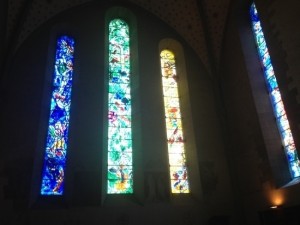
For a break between galleries, stroll through Old Town (Altstadt). Independent boutiques and cozy restaurants are packed amid medieval abbeys and Romanesque churches. Slip inside the Grossmünster for stunning Giacometti stained-glass windows and a fresco-lined crypt with a 15th Century Charlemagne statue. The must-sees, however, are the five stained-glass windows designed by Marc Chagall at the Fraumünster Church just over the Rathaus bridge. Every tourist will be there, but it is still worth it.
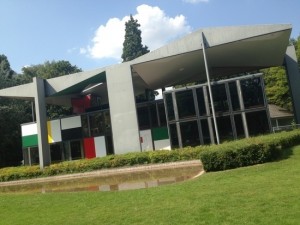
For locals, summer in Zurich revolves around the lake. Everyone has a favorite spot to picnic, meet with friends, and go swimming– and there are plenty of grassy patches to go around. Don’t miss the popular Gold Coast near the Chinagarten, known for its longer sunlight hours and expensive residences. If you go here be sure to check out the color-blocked exterior and sweeping rooftops of the Centre Le Corbusier, the last building designed by the famous Swiss architect.
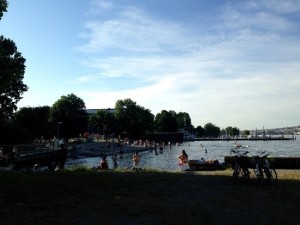
For a less touristy spot, the other side of Lake Zurich, known locally as “the shaded coast” is even better. Locals flock to relax by the water and barbeque on public grills, with the grounds full of both university students and families all day long. In terms of food, if you can avoid the Zurich prices, do it. Otherwise, be prepared to spend 6 Francs on a cup of coffee. My one food outing was to Tibits, a gourmet vegetarian café where you pay by weight. I bit my lip when my plate of quinoa and bok choy rung up to 20 Francs, but the meal was delicious.
Discovering the Brooklyn of Zurich
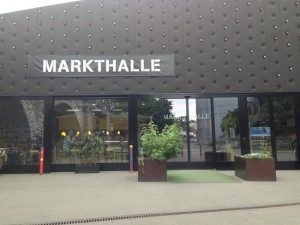
Further away from the town center is the gem of Zurich’s contemporary cultural community. Just south of the Escher-Wyss Platz and along the Limmastrasse, you’ll encounter seemingly endless art spaces, museums, and local markets within a former industrial zone – essentially the Brooklyn of Zurich. Two renovated spaces exist at the heart of the diverse community. The first is a 19th Century stone railway viaduct now home to shops, cafes, and an expansive indoor market called the Markthalle. Here you’ll find everything from fair trade Swiss chocolates to local honey and fresh fish— items you won’t see at the airport or tourist shops.
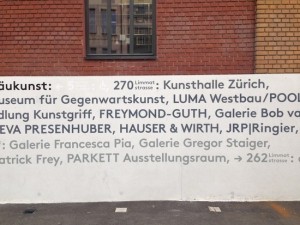
Across the street at 270 Limmastrasse is a former brewery turned art space, home to two museums, a handful of galleries, studios and event spaces, and a phenomenal bookstore. A combined ticket worth 20 Francs (12 for students) will grant you admission to both the Kunsthalle and Migros Museum of Contemporary Art and free roam of the space.
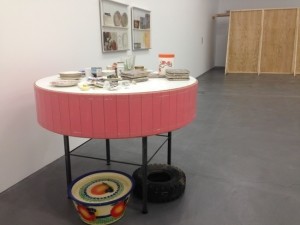
On view through August 18th at the Migros Museum are Collection on Display and Geoffrey Farmer: Let’s Make the Water Turn Black. Collection on Display is a selection of works from the museum’s collection, including pieces by John Armleder, Edward Krasinski, and Stefan Burger. The highlight for me was “Ohne Titel (Badonviller),” a 2010 sculptural arrangement by Manfred Pernice that explores ruins from a French ceramics factory within the historical context of the World Wars. Pernice’s arrangements confront sculptural tradition, political turmoil, an object’s history, and cultural norms in a provocative process of pairing and display.
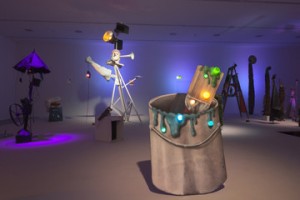
Moving upstairs, you will be mesmerized by Geoffrey Farmer’s Let’s Make the Water Turn Black. The theatrical installation presents a collection of objects and sounds that reflect the life of Frank Zappa. An entire stage of choreographed objects is activated by light, movement, and forms, producing a sculptural concert that can be experienced from various angles. The work held me in place for nearly an hour, my eyes never tiring of hypnotically jumping from sound to light. This work-in-progress is one of the most memorable contemporary installations I have seen in years.
A day trip to Bern or Basel complements the great offerings of Zurich
If you have time for day trips outside Zurich, the Paul Klee Museum and Kunsthalle in Bern are remarkable. And of course the capital of contemporary art in Switzerland, Basel, is only an hour away by train.
Investing time in the exploration of Zurich’s nooks and corners is well worth it. The city’s youthful energy is guiding it into becoming a leading cultural community in the country and throughout the world.


